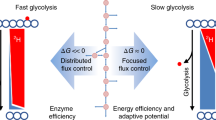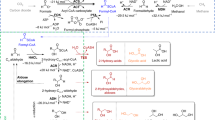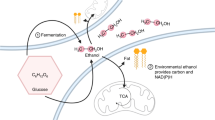Abstract
Glycolysis, or its variations, is a fundamental metabolic pathway in life that functions in almost all organisms to decompose external or intracellular sugars. The pathway involves the partial oxidation and splitting of sugars to pyruvate, which in turn is decarboxylated to produce acetyl-coenzyme A (CoA) for various biosynthetic purposes. The decarboxylation of pyruvate loses a carbon equivalent, and limits the theoretical carbon yield to only two moles of two-carbon (C2) metabolites per mole of hexose. This native route is a major source of carbon loss in biorefining and microbial carbon metabolism. Here we design and construct a non-oxidative, cyclic pathway that allows the production of stoichiometric amounts of C2 metabolites from hexose, pentose and triose phosphates without carbon loss. We tested this pathway, termed non-oxidative glycolysis (NOG), in vitro and in vivo in Escherichia coli. NOG enables complete carbon conservation in sugar catabolism to acetyl-CoA, and can be used in conjunction with CO2 fixation1 and other one-carbon (C1) assimilation pathways2 to achieve a 100% carbon yield to desirable fuels and chemicals.
This is a preview of subscription content, access via your institution
Access options
Subscribe to this journal
Receive 51 print issues and online access
$199.00 per year
only $3.90 per issue
Buy this article
- Purchase on Springer Link
- Instant access to full article PDF
Prices may be subject to local taxes which are calculated during checkout




Similar content being viewed by others
Change history
30 September 2013
Panel labels b and c were assigned to the wrong panels in Fig. 4 and have been corrected.
30 October 2013
Author affiliations and a text citation to Fig. 1a have been corrected, and a minor change to Fig. 1 has been made.
References
Bassham, J. et al. The path of carbon in photosynthesis. XXI. The cyclic regeneration of carbon dioxide acceptor. J. Am. Chem. Soc. 76, 1760–1770 (1954)
Yurimoto, H., Kato, N. & Sakai, Y. Assimilation, dissimilation, and detoxification of formaldehyde, a central metabolic intermediate of methylotrophic metabolism. Chem. Rec. 5, 367–375 (2005)
Nelson, D. & Cox, M. Lehninger Principles of Biochemistry (W. H. Freeman, 2005)
Peekhaus, N. & Conway, T. What’s for dinner?: Entner-Doudoroff metabolism in Escherichia coli . J. Bacteriol. 180, 3495–3502 (1998)
Guterl, J.-K. et al. Cell-free metabolic engineering: production of chemicals by minimized reaction cascades. ChemSusChem 5, 2165–2172 (2012)
Ye, X. et al. Synthetic metabolic engineering-a novel, simple technology for designing a chimeric metabolic pathway. Microb. Cell Fact. 11, 120 (2012)
Causey, T. & Ingram, L. Engineering the metabolism of Escherichia coli W3110 for the conversion of sugar to redox-neutral and oxidized products: homoacetate production. Proc. Natl Acad. Sci. USA 100, 825–832 (2003)
Tao, H., Gonzalez, R., Martinez, A. & Ingram, L. Engineering a homo-ethanol pathway in Escherichia coli: increased glycolytic flux and levels of expression of glycolytic genes during xylose fermentation. J. Bacteriol. 183, 2979–2988 (2001)
Berg, I. A., Kockelkorn, D., Buckel, W. & Fuchs, G. A 3-hydroxypropionate/4-hydroxybutyrate autotrophic carbon dioxide assimilation pathway in Archaea. Science 318, 1782–1786 (2007)
Ragsdale, S. W. & Pierce, E. Acetogenesis and the Wood–Ljungdahl pathway of CO2 fixation. Biochim. Biophys. Acta 1784, 1873–1898 (2008)
Dugar, D. & Stephanopoulos, G. Relative potential of biosynthetic pathways for biofuels and bio-based products. Nature Biotechnol. 29, 1074–1078 (2011)
Meléndez-Hevia, E. & Isidoro, A. The game of the pentose phosphate cycle. J. Theor. Biol. 117, 251–263 (1985)
Liao, J. C., Hou, S.-Y. & Chao, Y.-P. Pathway analysis, engineering, and physiological considerations for redirecting central metabolism. Biotechnol. Bioeng. 52, 129–140 (1996)
Schuster, R. & Schuster, S. Refined algorithm and computer program for calculating all non-negative fluxes admissible in steady states of biochemical reaction systems with or without some flux. Comput. Appl. Biosci. 9, 79–85 (1993)
Daldal, F. & Fraenkel, D. Assessment of a futile cycle involving reconversion of fructose 6-phosphate to fructose 1, 6-bisphosphate during gluconeogenic growth of Escherichia coli . J. Bacteriol. 153, 390–394 (1983)
Patnaik, R., Roof, W. D., Young, R. F. & Liao, J. C. Stimulation of glucose catabolism in Escherichia coli by a potential futile cycle. J. Bacteriol. 174, 7527–7532 (1992)
Roseman, S. & Meadow, N. D. Signal transduction by the bacterial phosphotransferase system. J. Biol. Chem. 265, 2993–2996 (1990)
Gonzalez, R., Tao, H., Shanmugam, K. T., York, S. W. & Ingram, L. O. Global gene expression differences associated with changes in glycolytic flux and growth rate in Escherichia coli during the fermentation of glucose and xylose. Biotechnol. Prog. 18, 6–20 (2002)
Lutz, R. & Bujard, H. Independent and tight regulation of transcriptional units in Escherichia coli via the LacR/O, the TetR/O and AraC/I1–I2 regulatory elements. Nucleic Acids Res. 25, 1203 (1997)
Atsumi, S. et al. Metabolic engineering of Escherichia coli for 1-butanol production. Metab. Eng. 10, 305–311 (2008)
Li, H. et al. Integrated electromicrobial conversion of CO2 to higher alcohols. Science 335, 1596 (2012)
Gronenberg, L. S., Marcheschi, R. J. & Liao, J. C. Next generation biofuel engineering in prokaryotes. Curr. Opin. Chem. Biol. 17, 462–471 (2013)
Liu, L. et al. Phosphoketolase pathway for xylose catabolism in Clostridium acetobutylicum revealed by 13C-metabolic flux analysis. J. Bacteriol. 194, 5413–5422 (2012)
Yin, X., Chambers, J. R., Barlow, K., Park, A. S. & Wheatcroft, R. The gene encoding xylulose-5-phosphate/fructose-6-phosphate phosphoketolase (xfp) is conserved among Bifidobacterium species within a more variable region of the genome and both are useful for strain identification. FEMS Microbiol. Lett. 246, 251–257 (2005)
Drake, H. L. & Daniel, S. L. Physiology of the thermophilic acetogen Moorella thermoacetica . Res. Microbiol. 155, 869–883 (2004)
Ragsdale, S. W. Metals and their scaffolds to promote difficult enzymatic reactions. Chem. Rev. 106, 3317–3337 (2006)
Lan, E. I. & Liao, J. C. ATP drives direct photosynthetic production of 1-butanol in cyanobacteria. Proc. Natl Acad. Sci. USA 109, 6018–6023 (2012)
Liu, X., Sheng, J. & Curtiss, R. Fatty acid production in genetically modified cyanobacteria. Proc. Natl Acad. Sci. USA 108, 6899–6904 (2011)
Tcherkez, G. G. B., Farquhar, G. D. & Andrews, T. J. Despite slow catalysis and confused substrate specificity, all ribulose bisphosphate carboxylases may be nearly perfectly optimized. Proc. Natl Acad. Sci. USA 103, 7246–7251 (2006)
Aslanidis, C. & de Jong, P. J. Ligation-independent cloning of PCR products (LIC-PCR). Nucleic Acids Res. 18, 6069–6074 (1990)
Baba, T. et al. Construction of Escherichia coli K-12 in-frame, single-gene knockout mutants: the Keio collection. Mol. Syst. Biol. 2, 2006.0008 (2006)
Acknowledgements
This work was partially supported by National Science Foundation (NSF) grant MCB-1139318 and Department of Energy (DOE) grant DE0-SC0006698. I.W.B. was supported by NSF Integrative Graduate Education and Research Traineeship (IGERT) grant no. 0903720.
Author information
Authors and Affiliations
Contributions
I.W.B. and J.C.L. conceived the project, designed the experiments, analysed the data, and wrote the manuscript. I.W.B. performed experiments, and T.-S.L. assisted in experiments.
Corresponding author
Ethics declarations
Competing interests
The authors declare no competing financial interests.
Supplementary information
Supplementary Information
This file contains Supplementary Figures 1-8, Supplementary Tables 1-8 and additional references. (PDF 1153 kb)
Rights and permissions
About this article
Cite this article
Bogorad, I., Lin, TS. & Liao, J. Synthetic non-oxidative glycolysis enables complete carbon conservation. Nature 502, 693–697 (2013). https://doi.org/10.1038/nature12575
Received:
Accepted:
Published:
Issue Date:
DOI: https://doi.org/10.1038/nature12575
This article is cited by
-
Optimization of trans-4-hydroxyproline synthesis pathway by rearrangement center carbon metabolism in Escherichia coli
Microbial Cell Factories (2023)
-
Advances in the optimization of central carbon metabolism in metabolic engineering
Microbial Cell Factories (2023)
-
Increasing cellular fitness and product yields in Pseudomonas putida through an engineered phosphoketolase shunt
Microbial Cell Factories (2023)
-
Synthetic anaplerotic modules for the direct synthesis of complex molecules from CO2
Nature Chemical Biology (2023)
-
Engineering a synthetic energy-efficient formaldehyde assimilation cycle in Escherichia coli
Nature Communications (2023)
Comments
By submitting a comment you agree to abide by our Terms and Community Guidelines. If you find something abusive or that does not comply with our terms or guidelines please flag it as inappropriate.



